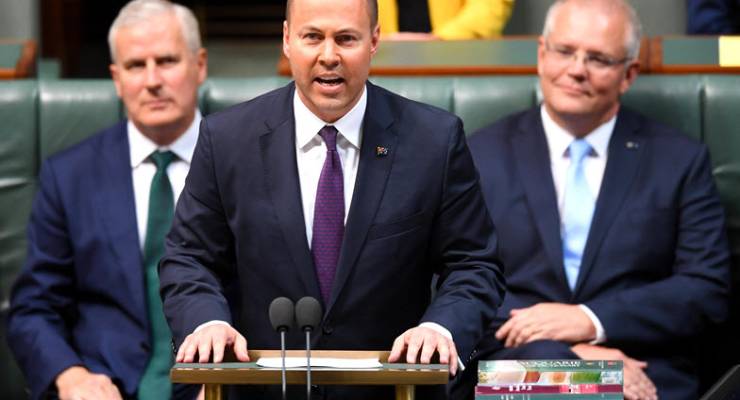
The centrepiece of Treasurer Josh Frydenberg’s 2018-19 budget is immediate tax cuts. The government is trumpeting a $1080 personal income tax cut for low- and middle-income earners.
The cut is the full $1080 for people earning between $50,000 and $80,000. It scales up from $87 for people earning $21,000 and scales out above $80,000 so that people earning $200,000 get just $135. That money will come back to us in in the tax returns we get around August this year and it will no doubt be very welcome for millions of Australians.
But there’s a catch.
Half of the tax cut was announced last year. They’re trying to get credit for announcing a $530 tax cut last year and a $1080 tax cut this year too. But the new announcement is a tax cut of about $550. The new announcement is a bump of about $10 a week. Is that enough to take to an election?
There’s also another sneaky manoeuvre. The full cost is not captured in this budget. The government tucked away an enormous multibillion-dollar provision late last year in the Mid-Year Economic and Fiscal Outlook (MYEFO). That means that the new impact on the budget is very modest — the budget implies these tax cuts cost just $750 million next year. But the true cost in 2019-20 is $3.5 billion and, of course, the “provision” in MYEFO was rendered invisible, included only as a total in a column somewhere, rather than clearly announced.
How do these tax cuts work?
The immediate tax cut offered by the government is focused on low- and middle-income earners. That’s rare for tax cuts. It can be focused on the needier taxpayers because of a special structure the government is using that doesn’t fiddle with tax rates or tax brackets.
The way tax brackets work means that when you cut a tax rate, everyone gets a benefit, rich and poor alike. Even the richest people pay just 19% tax on the dollars they earn between $18,000 and $37,000. So, if you cut the tax rate on money earned in that tax bracket, everyone benefits. That causes two problems:
- The tax cuts go to everyone — even those who don’t necessarily need them.
- They get very expensive.
The $1080 tax cut is not provided via changes to tax brackets or tax rates. They instead come through a system called the Low- and Middle-Income Tax Offset (LMITO) — this is a payment that comes back to low- and middle-income earners after the tax return is lodged.
Cutting taxes like this — focused on the neediest — is probably more of a traditional Labor move. But, due to constrained fiscal circumstances and the need to reach out to the marginal voter, it is now the method that the Coalition has adopted. The LMITO is limited; it will expire after four years.
But wait there’s more…
The big part of the Coalition’s tax changes comes in the years 2022-23 and 2024-25. This part of the tax cuts is anything but immediate. The government could have changed twice by then. God knows how many prime ministers we will have burned through by then.
In 2022-23 the government will increase the low-income tax offset too. And in 2024-25 it will start to fiddle with tax rates. The 32.5% tax rate will fall to 30%. This is a new announcement but it combines with an old announcement which is to dramatically increase the size of that tax bracket.
The 32.5% rate currently applies to money earned between $37,001 and $87,000. After 2024-25, the new 30% rate will apply to money earned between $37,001 and $180,000.
What’s the political context?
Bill Shorten can eat this for breakfast. It is cheap and it is targeted at low- to middle-income earners. We all know he has a buffer to spend big to win the election. We all know his tax increases in other areas give him more money to spend on voters. Will he let the Coalition get a big advantage on him in this area with an election just weeks away? We will find out when he delivers his budget reply later this week.








The increase in my health fund costs should eat the tax break. What bullshit. Damage the revenue base for nothing…oh Costello and Howard our heroes. As a proponent of Fair Funding Now, I will be wearing black if these nitwits win.
“The cut is the full $1080 for people earning between $50,000 and $80,000. It scales up from $87 for people earning $21,000 and scales out above $80,000 so that people earning $200,000 get just $135.”
The people who earn the least get the smallest relief?
Just what I was thinking.
The $1080 should go to low income earners, scaling back as their income rises.
They have it arse about.
And why do people earning $135,000 get any offset?
Sorry, that was meant to be people earning $200,000.
Another thought.
$1080 in the hands of those on low incomes will, most likely, all go back into the economy through consumption.
$1080 for those earning $80,000 may not – some may be put away for a rainy day.
As a boy I always wondered where the term “You must be joshing”, which I thought meant “you must be telling fibs” came from. Frydenberg keeps spruking that he has brought the budget back to surplus. Of course he hasn’t, we won’t know whether the budget is in surplus for another 15 months. Once again Frydeneberg is fibbing and I finally know why it’s called Joshing.